Human Resource Management Report: Planning and Strategy for Growth
VerifiedAdded on 2019/12/28
|18
|6056
|206
Report
AI Summary
This report delves into the multifaceted realm of Human Resource Management (HRM), exploring its crucial role in organizational success. It begins by differentiating between personnel management and HRM, highlighting the strategic importance of the latter in managing people and their strengths within organizations. The report then outlines the key functions of HRM, including recruitment, staffing, training and development, and performance management, emphasizing their contribution to achieving organizational goals. It also examines the roles and responsibilities of line managers in HRM, particularly in large organizations like Asda and Nike. Furthermore, the report discusses the impact of legal and regulatory frameworks on HRM practices, such as recruitment and selection. The report also covers human resource planning, its stages, and the reasons behind it, including meeting future demands and adapting to changes. It compares recruitment and selection processes in Asda and Tesco and examines the effectiveness of various techniques. Finally, it explores the link between motivational theory and rewards, the process of job evaluation, the effectiveness of reward systems, and methods for monitoring employee performance, concluding with the reasons for employment cessation and related procedures.
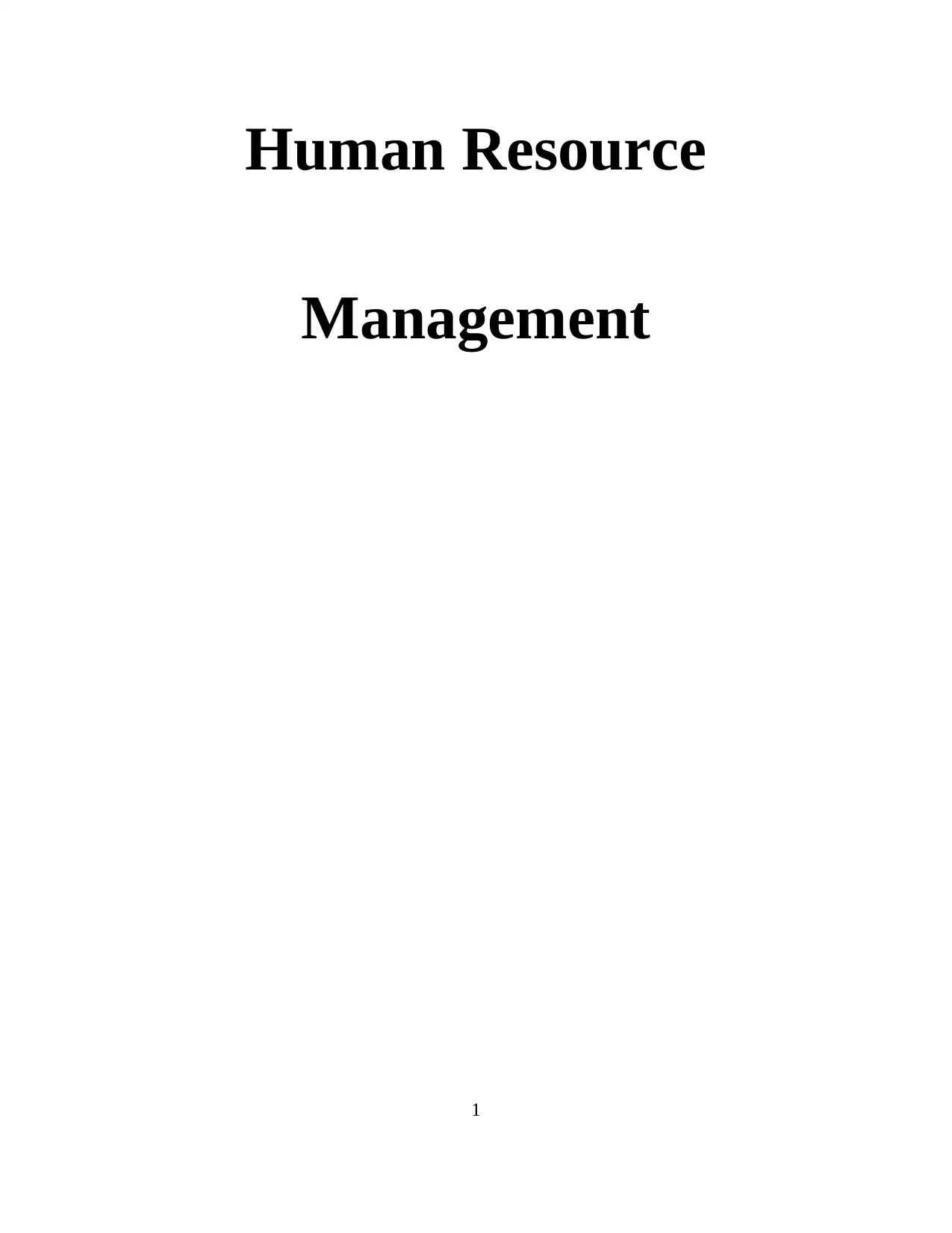
Human Resource
Management
1
Management
1
Paraphrase This Document
Need a fresh take? Get an instant paraphrase of this document with our AI Paraphraser
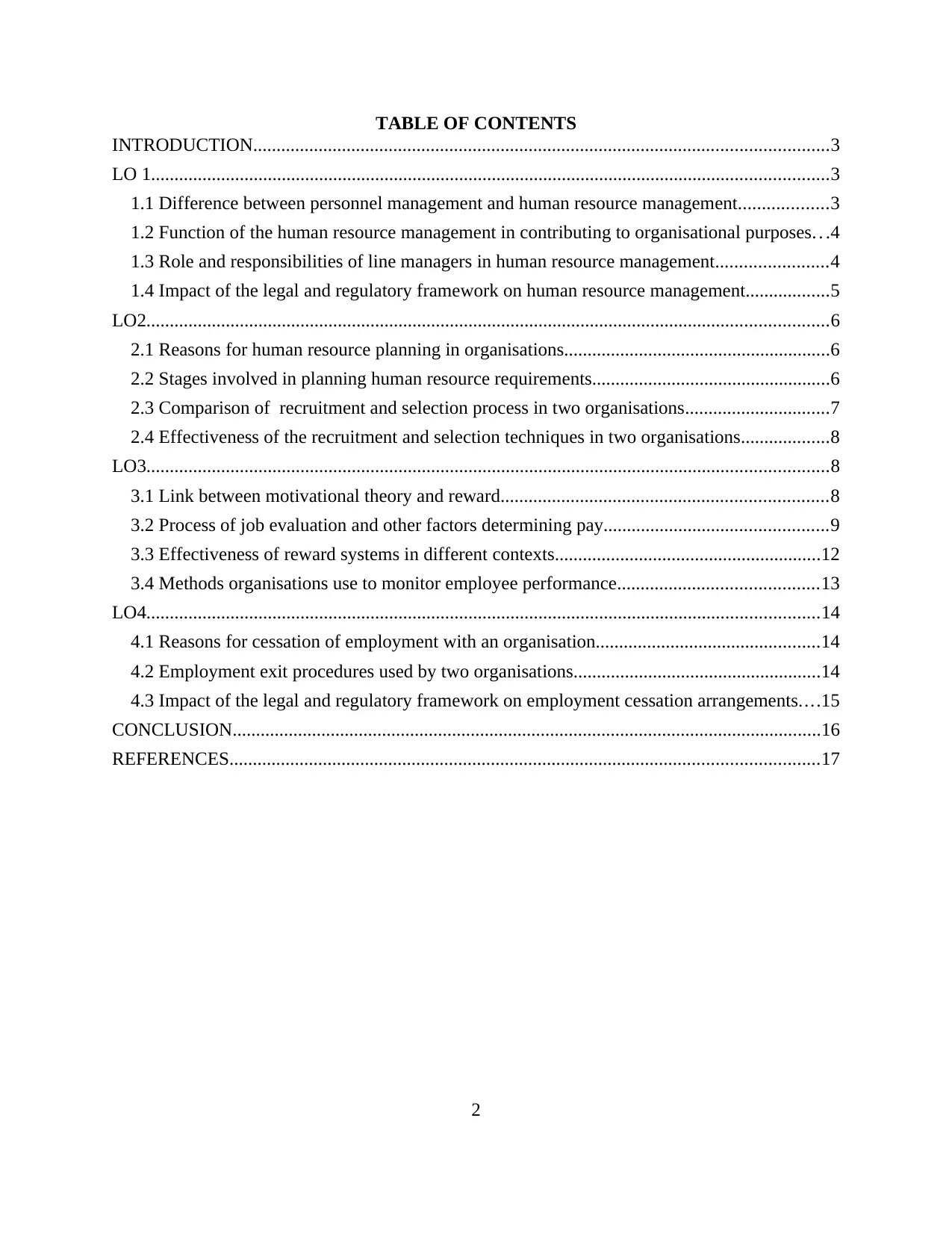
TABLE OF CONTENTS
INTRODUCTION...........................................................................................................................3
LO 1.................................................................................................................................................3
1.1 Difference between personnel management and human resource management...................3
1.2 Function of the human resource management in contributing to organisational purposes. . .4
1.3 Role and responsibilities of line managers in human resource management........................4
1.4 Impact of the legal and regulatory framework on human resource management..................5
LO2..................................................................................................................................................6
2.1 Reasons for human resource planning in organisations.........................................................6
2.2 Stages involved in planning human resource requirements...................................................6
2.3 Comparison of recruitment and selection process in two organisations...............................7
2.4 Effectiveness of the recruitment and selection techniques in two organisations...................8
LO3..................................................................................................................................................8
3.1 Link between motivational theory and reward......................................................................8
3.2 Process of job evaluation and other factors determining pay................................................9
3.3 Effectiveness of reward systems in different contexts.........................................................12
3.4 Methods organisations use to monitor employee performance...........................................13
LO4................................................................................................................................................14
4.1 Reasons for cessation of employment with an organisation................................................14
4.2 Employment exit procedures used by two organisations.....................................................14
4.3 Impact of the legal and regulatory framework on employment cessation arrangements....15
CONCLUSION..............................................................................................................................16
REFERENCES..............................................................................................................................17
2
INTRODUCTION...........................................................................................................................3
LO 1.................................................................................................................................................3
1.1 Difference between personnel management and human resource management...................3
1.2 Function of the human resource management in contributing to organisational purposes. . .4
1.3 Role and responsibilities of line managers in human resource management........................4
1.4 Impact of the legal and regulatory framework on human resource management..................5
LO2..................................................................................................................................................6
2.1 Reasons for human resource planning in organisations.........................................................6
2.2 Stages involved in planning human resource requirements...................................................6
2.3 Comparison of recruitment and selection process in two organisations...............................7
2.4 Effectiveness of the recruitment and selection techniques in two organisations...................8
LO3..................................................................................................................................................8
3.1 Link between motivational theory and reward......................................................................8
3.2 Process of job evaluation and other factors determining pay................................................9
3.3 Effectiveness of reward systems in different contexts.........................................................12
3.4 Methods organisations use to monitor employee performance...........................................13
LO4................................................................................................................................................14
4.1 Reasons for cessation of employment with an organisation................................................14
4.2 Employment exit procedures used by two organisations.....................................................14
4.3 Impact of the legal and regulatory framework on employment cessation arrangements....15
CONCLUSION..............................................................................................................................16
REFERENCES..............................................................................................................................17
2
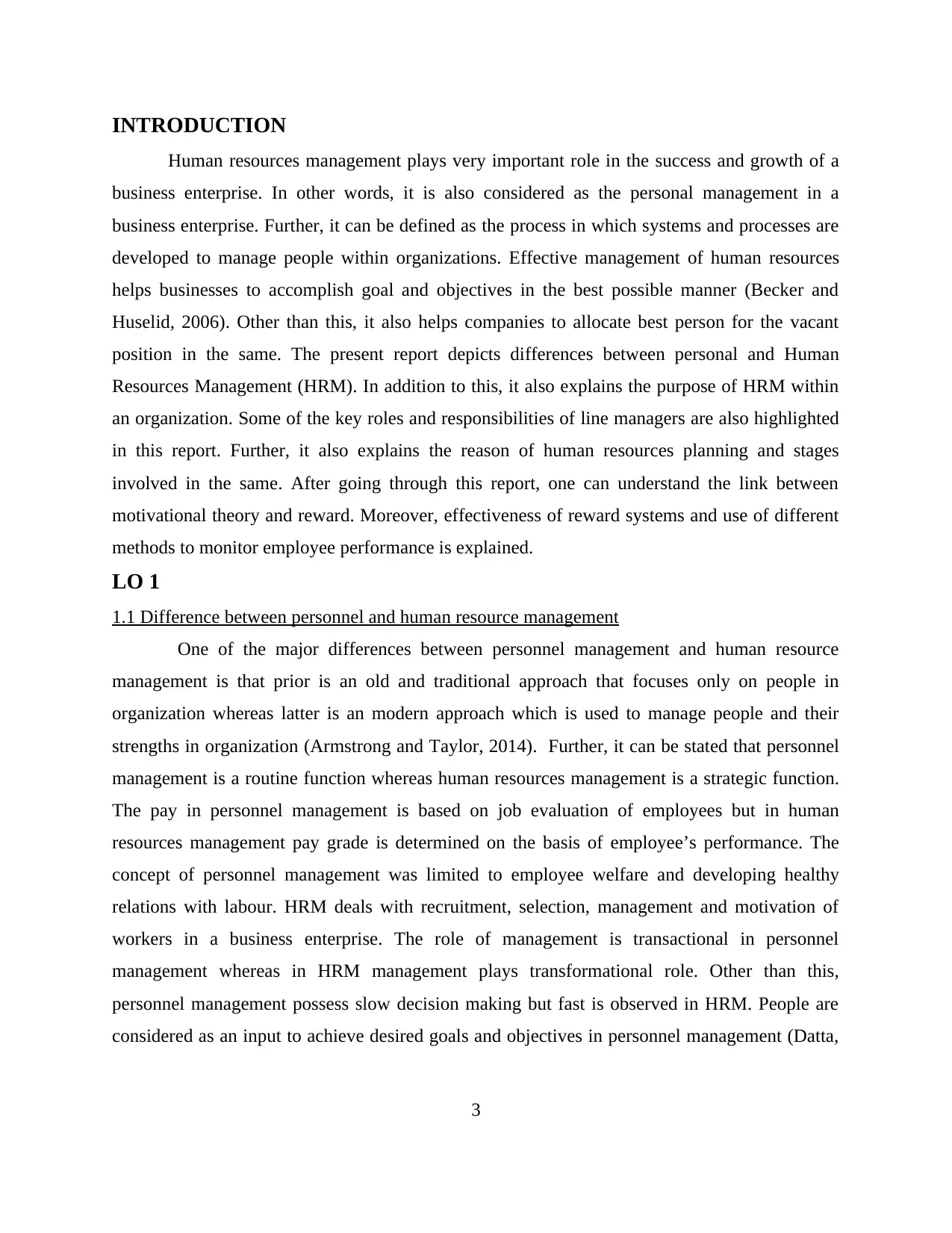
INTRODUCTION
Human resources management plays very important role in the success and growth of a
business enterprise. In other words, it is also considered as the personal management in a
business enterprise. Further, it can be defined as the process in which systems and processes are
developed to manage people within organizations. Effective management of human resources
helps businesses to accomplish goal and objectives in the best possible manner (Becker and
Huselid, 2006). Other than this, it also helps companies to allocate best person for the vacant
position in the same. The present report depicts differences between personal and Human
Resources Management (HRM). In addition to this, it also explains the purpose of HRM within
an organization. Some of the key roles and responsibilities of line managers are also highlighted
in this report. Further, it also explains the reason of human resources planning and stages
involved in the same. After going through this report, one can understand the link between
motivational theory and reward. Moreover, effectiveness of reward systems and use of different
methods to monitor employee performance is explained.
LO 1
1.1 Difference between personnel and human resource management
One of the major differences between personnel management and human resource
management is that prior is an old and traditional approach that focuses only on people in
organization whereas latter is an modern approach which is used to manage people and their
strengths in organization (Armstrong and Taylor, 2014). Further, it can be stated that personnel
management is a routine function whereas human resources management is a strategic function.
The pay in personnel management is based on job evaluation of employees but in human
resources management pay grade is determined on the basis of employee’s performance. The
concept of personnel management was limited to employee welfare and developing healthy
relations with labour. HRM deals with recruitment, selection, management and motivation of
workers in a business enterprise. The role of management is transactional in personnel
management whereas in HRM management plays transformational role. Other than this,
personnel management possess slow decision making but fast is observed in HRM. People are
considered as an input to achieve desired goals and objectives in personnel management (Datta,
3
Human resources management plays very important role in the success and growth of a
business enterprise. In other words, it is also considered as the personal management in a
business enterprise. Further, it can be defined as the process in which systems and processes are
developed to manage people within organizations. Effective management of human resources
helps businesses to accomplish goal and objectives in the best possible manner (Becker and
Huselid, 2006). Other than this, it also helps companies to allocate best person for the vacant
position in the same. The present report depicts differences between personal and Human
Resources Management (HRM). In addition to this, it also explains the purpose of HRM within
an organization. Some of the key roles and responsibilities of line managers are also highlighted
in this report. Further, it also explains the reason of human resources planning and stages
involved in the same. After going through this report, one can understand the link between
motivational theory and reward. Moreover, effectiveness of reward systems and use of different
methods to monitor employee performance is explained.
LO 1
1.1 Difference between personnel and human resource management
One of the major differences between personnel management and human resource
management is that prior is an old and traditional approach that focuses only on people in
organization whereas latter is an modern approach which is used to manage people and their
strengths in organization (Armstrong and Taylor, 2014). Further, it can be stated that personnel
management is a routine function whereas human resources management is a strategic function.
The pay in personnel management is based on job evaluation of employees but in human
resources management pay grade is determined on the basis of employee’s performance. The
concept of personnel management was limited to employee welfare and developing healthy
relations with labour. HRM deals with recruitment, selection, management and motivation of
workers in a business enterprise. The role of management is transactional in personnel
management whereas in HRM management plays transformational role. Other than this,
personnel management possess slow decision making but fast is observed in HRM. People are
considered as an input to achieve desired goals and objectives in personnel management (Datta,
3
⊘ This is a preview!⊘
Do you want full access?
Subscribe today to unlock all pages.

Trusted by 1+ million students worldwide
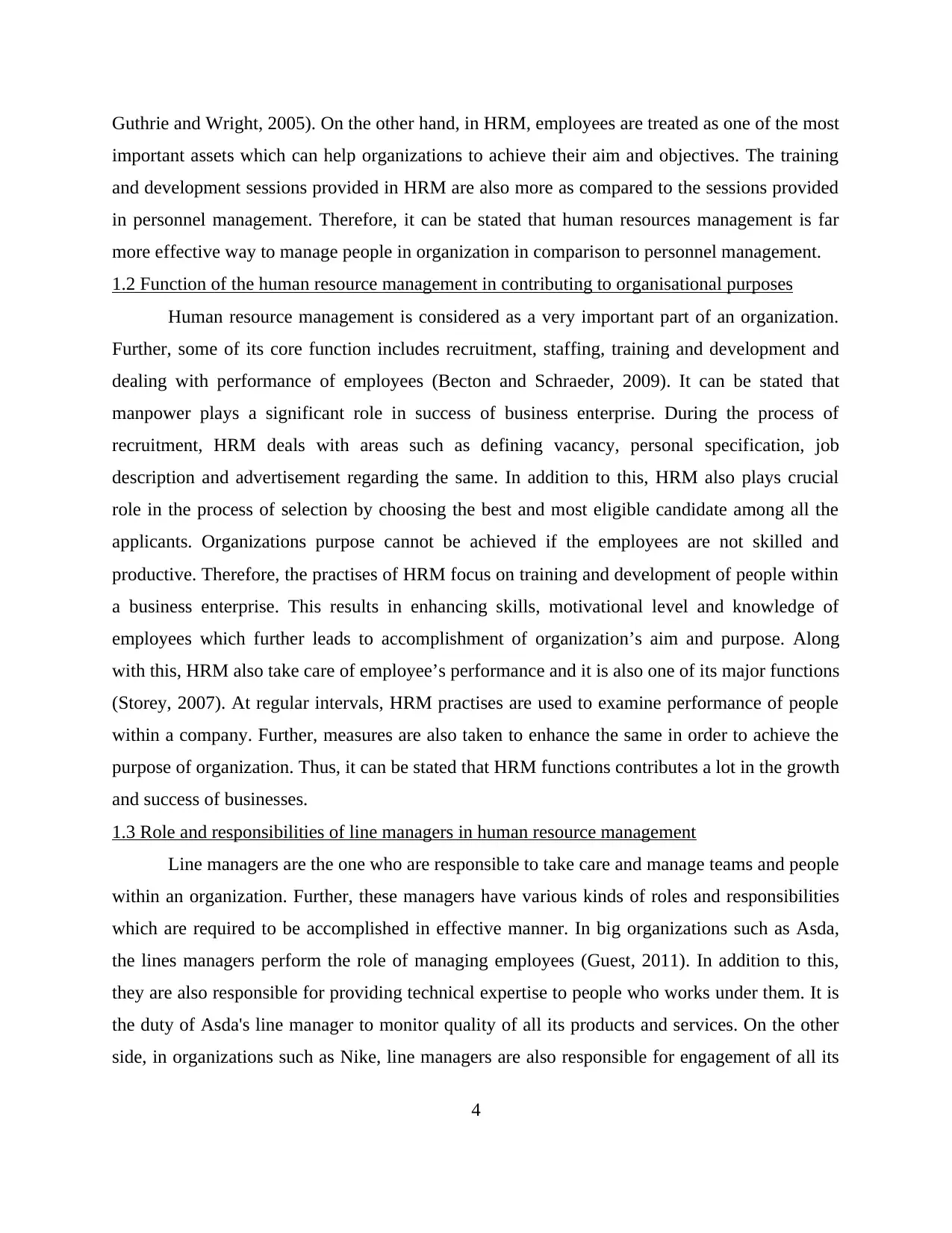
Guthrie and Wright, 2005). On the other hand, in HRM, employees are treated as one of the most
important assets which can help organizations to achieve their aim and objectives. The training
and development sessions provided in HRM are also more as compared to the sessions provided
in personnel management. Therefore, it can be stated that human resources management is far
more effective way to manage people in organization in comparison to personnel management.
1.2 Function of the human resource management in contributing to organisational purposes
Human resource management is considered as a very important part of an organization.
Further, some of its core function includes recruitment, staffing, training and development and
dealing with performance of employees (Becton and Schraeder, 2009). It can be stated that
manpower plays a significant role in success of business enterprise. During the process of
recruitment, HRM deals with areas such as defining vacancy, personal specification, job
description and advertisement regarding the same. In addition to this, HRM also plays crucial
role in the process of selection by choosing the best and most eligible candidate among all the
applicants. Organizations purpose cannot be achieved if the employees are not skilled and
productive. Therefore, the practises of HRM focus on training and development of people within
a business enterprise. This results in enhancing skills, motivational level and knowledge of
employees which further leads to accomplishment of organization’s aim and purpose. Along
with this, HRM also take care of employee’s performance and it is also one of its major functions
(Storey, 2007). At regular intervals, HRM practises are used to examine performance of people
within a company. Further, measures are also taken to enhance the same in order to achieve the
purpose of organization. Thus, it can be stated that HRM functions contributes a lot in the growth
and success of businesses.
1.3 Role and responsibilities of line managers in human resource management
Line managers are the one who are responsible to take care and manage teams and people
within an organization. Further, these managers have various kinds of roles and responsibilities
which are required to be accomplished in effective manner. In big organizations such as Asda,
the lines managers perform the role of managing employees (Guest, 2011). In addition to this,
they are also responsible for providing technical expertise to people who works under them. It is
the duty of Asda's line manager to monitor quality of all its products and services. On the other
side, in organizations such as Nike, line managers are also responsible for engagement of all its
4
important assets which can help organizations to achieve their aim and objectives. The training
and development sessions provided in HRM are also more as compared to the sessions provided
in personnel management. Therefore, it can be stated that human resources management is far
more effective way to manage people in organization in comparison to personnel management.
1.2 Function of the human resource management in contributing to organisational purposes
Human resource management is considered as a very important part of an organization.
Further, some of its core function includes recruitment, staffing, training and development and
dealing with performance of employees (Becton and Schraeder, 2009). It can be stated that
manpower plays a significant role in success of business enterprise. During the process of
recruitment, HRM deals with areas such as defining vacancy, personal specification, job
description and advertisement regarding the same. In addition to this, HRM also plays crucial
role in the process of selection by choosing the best and most eligible candidate among all the
applicants. Organizations purpose cannot be achieved if the employees are not skilled and
productive. Therefore, the practises of HRM focus on training and development of people within
a business enterprise. This results in enhancing skills, motivational level and knowledge of
employees which further leads to accomplishment of organization’s aim and purpose. Along
with this, HRM also take care of employee’s performance and it is also one of its major functions
(Storey, 2007). At regular intervals, HRM practises are used to examine performance of people
within a company. Further, measures are also taken to enhance the same in order to achieve the
purpose of organization. Thus, it can be stated that HRM functions contributes a lot in the growth
and success of businesses.
1.3 Role and responsibilities of line managers in human resource management
Line managers are the one who are responsible to take care and manage teams and people
within an organization. Further, these managers have various kinds of roles and responsibilities
which are required to be accomplished in effective manner. In big organizations such as Asda,
the lines managers perform the role of managing employees (Guest, 2011). In addition to this,
they are also responsible for providing technical expertise to people who works under them. It is
the duty of Asda's line manager to monitor quality of all its products and services. On the other
side, in organizations such as Nike, line managers are also responsible for engagement of all its
4
Paraphrase This Document
Need a fresh take? Get an instant paraphrase of this document with our AI Paraphraser
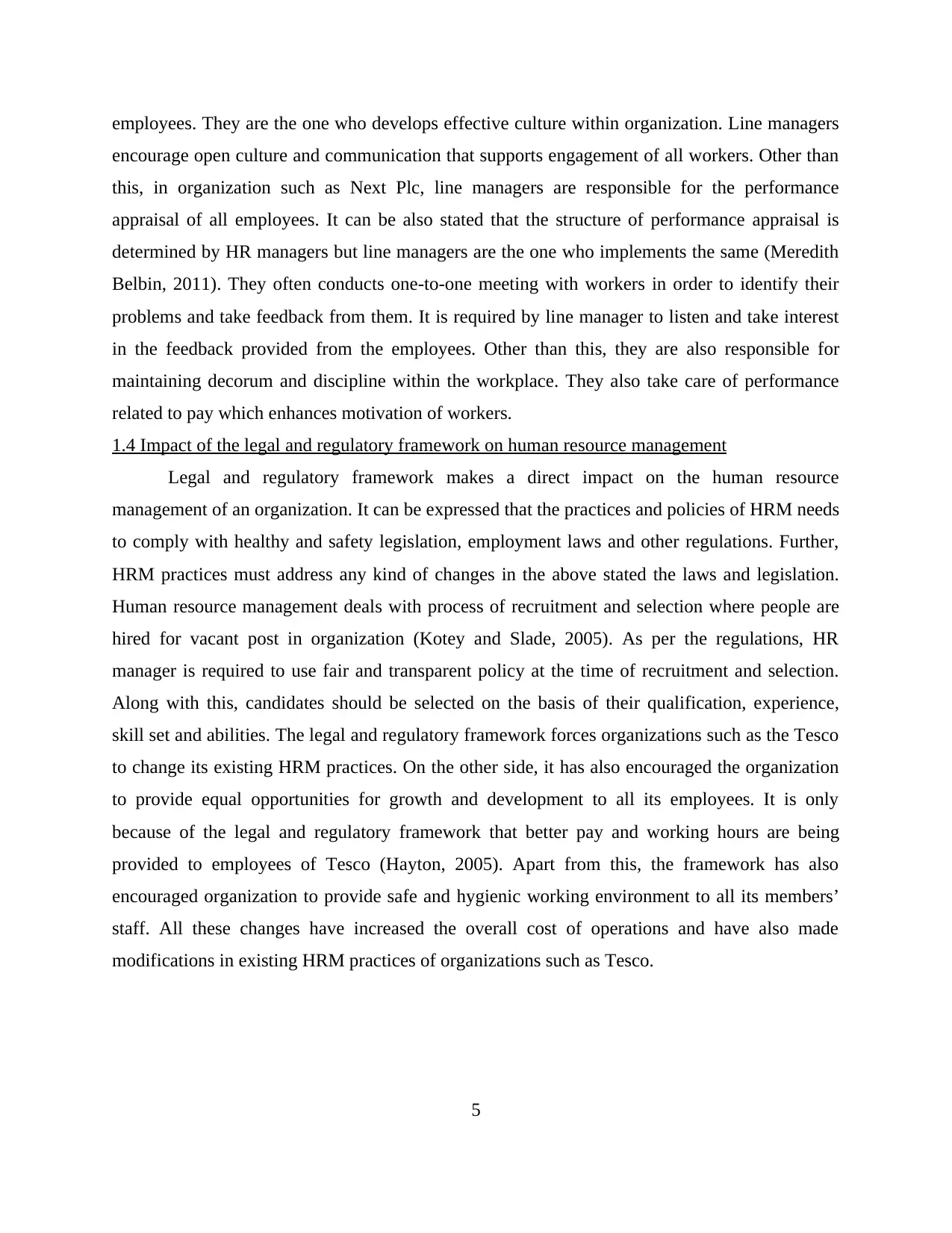
employees. They are the one who develops effective culture within organization. Line managers
encourage open culture and communication that supports engagement of all workers. Other than
this, in organization such as Next Plc, line managers are responsible for the performance
appraisal of all employees. It can be also stated that the structure of performance appraisal is
determined by HR managers but line managers are the one who implements the same (Meredith
Belbin, 2011). They often conducts one-to-one meeting with workers in order to identify their
problems and take feedback from them. It is required by line manager to listen and take interest
in the feedback provided from the employees. Other than this, they are also responsible for
maintaining decorum and discipline within the workplace. They also take care of performance
related to pay which enhances motivation of workers.
1.4 Impact of the legal and regulatory framework on human resource management
Legal and regulatory framework makes a direct impact on the human resource
management of an organization. It can be expressed that the practices and policies of HRM needs
to comply with healthy and safety legislation, employment laws and other regulations. Further,
HRM practices must address any kind of changes in the above stated the laws and legislation.
Human resource management deals with process of recruitment and selection where people are
hired for vacant post in organization (Kotey and Slade, 2005). As per the regulations, HR
manager is required to use fair and transparent policy at the time of recruitment and selection.
Along with this, candidates should be selected on the basis of their qualification, experience,
skill set and abilities. The legal and regulatory framework forces organizations such as the Tesco
to change its existing HRM practices. On the other side, it has also encouraged the organization
to provide equal opportunities for growth and development to all its employees. It is only
because of the legal and regulatory framework that better pay and working hours are being
provided to employees of Tesco (Hayton, 2005). Apart from this, the framework has also
encouraged organization to provide safe and hygienic working environment to all its members’
staff. All these changes have increased the overall cost of operations and have also made
modifications in existing HRM practices of organizations such as Tesco.
5
encourage open culture and communication that supports engagement of all workers. Other than
this, in organization such as Next Plc, line managers are responsible for the performance
appraisal of all employees. It can be also stated that the structure of performance appraisal is
determined by HR managers but line managers are the one who implements the same (Meredith
Belbin, 2011). They often conducts one-to-one meeting with workers in order to identify their
problems and take feedback from them. It is required by line manager to listen and take interest
in the feedback provided from the employees. Other than this, they are also responsible for
maintaining decorum and discipline within the workplace. They also take care of performance
related to pay which enhances motivation of workers.
1.4 Impact of the legal and regulatory framework on human resource management
Legal and regulatory framework makes a direct impact on the human resource
management of an organization. It can be expressed that the practices and policies of HRM needs
to comply with healthy and safety legislation, employment laws and other regulations. Further,
HRM practices must address any kind of changes in the above stated the laws and legislation.
Human resource management deals with process of recruitment and selection where people are
hired for vacant post in organization (Kotey and Slade, 2005). As per the regulations, HR
manager is required to use fair and transparent policy at the time of recruitment and selection.
Along with this, candidates should be selected on the basis of their qualification, experience,
skill set and abilities. The legal and regulatory framework forces organizations such as the Tesco
to change its existing HRM practices. On the other side, it has also encouraged the organization
to provide equal opportunities for growth and development to all its employees. It is only
because of the legal and regulatory framework that better pay and working hours are being
provided to employees of Tesco (Hayton, 2005). Apart from this, the framework has also
encouraged organization to provide safe and hygienic working environment to all its members’
staff. All these changes have increased the overall cost of operations and have also made
modifications in existing HRM practices of organizations such as Tesco.
5
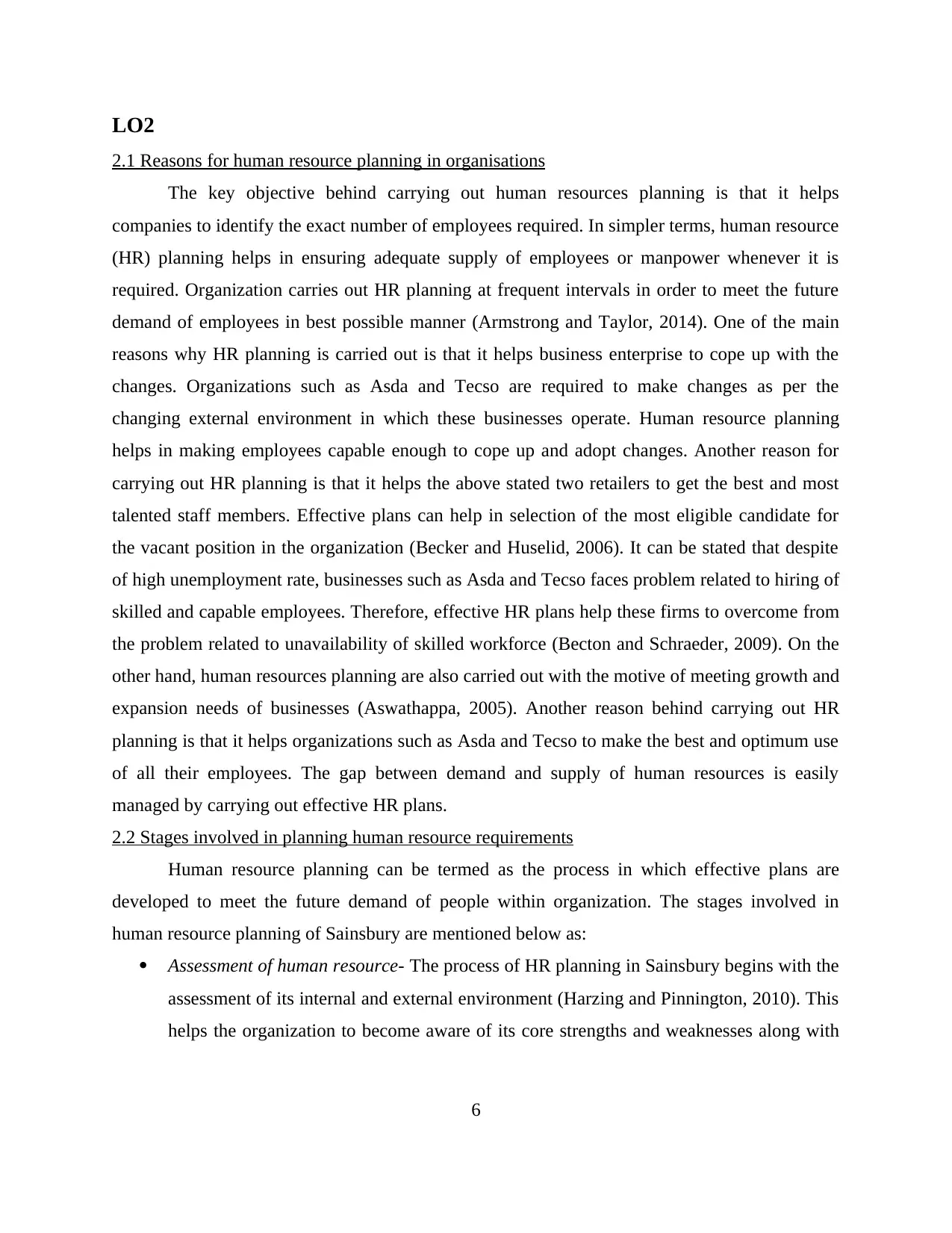
LO2
2.1 Reasons for human resource planning in organisations
The key objective behind carrying out human resources planning is that it helps
companies to identify the exact number of employees required. In simpler terms, human resource
(HR) planning helps in ensuring adequate supply of employees or manpower whenever it is
required. Organization carries out HR planning at frequent intervals in order to meet the future
demand of employees in best possible manner (Armstrong and Taylor, 2014). One of the main
reasons why HR planning is carried out is that it helps business enterprise to cope up with the
changes. Organizations such as Asda and Tecso are required to make changes as per the
changing external environment in which these businesses operate. Human resource planning
helps in making employees capable enough to cope up and adopt changes. Another reason for
carrying out HR planning is that it helps the above stated two retailers to get the best and most
talented staff members. Effective plans can help in selection of the most eligible candidate for
the vacant position in the organization (Becker and Huselid, 2006). It can be stated that despite
of high unemployment rate, businesses such as Asda and Tecso faces problem related to hiring of
skilled and capable employees. Therefore, effective HR plans help these firms to overcome from
the problem related to unavailability of skilled workforce (Becton and Schraeder, 2009). On the
other hand, human resources planning are also carried out with the motive of meeting growth and
expansion needs of businesses (Aswathappa, 2005). Another reason behind carrying out HR
planning is that it helps organizations such as Asda and Tecso to make the best and optimum use
of all their employees. The gap between demand and supply of human resources is easily
managed by carrying out effective HR plans.
2.2 Stages involved in planning human resource requirements
Human resource planning can be termed as the process in which effective plans are
developed to meet the future demand of people within organization. The stages involved in
human resource planning of Sainsbury are mentioned below as:
Assessment of human resource- The process of HR planning in Sainsbury begins with the
assessment of its internal and external environment (Harzing and Pinnington, 2010). This
helps the organization to become aware of its core strengths and weaknesses along with
6
2.1 Reasons for human resource planning in organisations
The key objective behind carrying out human resources planning is that it helps
companies to identify the exact number of employees required. In simpler terms, human resource
(HR) planning helps in ensuring adequate supply of employees or manpower whenever it is
required. Organization carries out HR planning at frequent intervals in order to meet the future
demand of employees in best possible manner (Armstrong and Taylor, 2014). One of the main
reasons why HR planning is carried out is that it helps business enterprise to cope up with the
changes. Organizations such as Asda and Tecso are required to make changes as per the
changing external environment in which these businesses operate. Human resource planning
helps in making employees capable enough to cope up and adopt changes. Another reason for
carrying out HR planning is that it helps the above stated two retailers to get the best and most
talented staff members. Effective plans can help in selection of the most eligible candidate for
the vacant position in the organization (Becker and Huselid, 2006). It can be stated that despite
of high unemployment rate, businesses such as Asda and Tecso faces problem related to hiring of
skilled and capable employees. Therefore, effective HR plans help these firms to overcome from
the problem related to unavailability of skilled workforce (Becton and Schraeder, 2009). On the
other hand, human resources planning are also carried out with the motive of meeting growth and
expansion needs of businesses (Aswathappa, 2005). Another reason behind carrying out HR
planning is that it helps organizations such as Asda and Tecso to make the best and optimum use
of all their employees. The gap between demand and supply of human resources is easily
managed by carrying out effective HR plans.
2.2 Stages involved in planning human resource requirements
Human resource planning can be termed as the process in which effective plans are
developed to meet the future demand of people within organization. The stages involved in
human resource planning of Sainsbury are mentioned below as:
Assessment of human resource- The process of HR planning in Sainsbury begins with the
assessment of its internal and external environment (Harzing and Pinnington, 2010). This
helps the organization to become aware of its core strengths and weaknesses along with
6
⊘ This is a preview!⊘
Do you want full access?
Subscribe today to unlock all pages.

Trusted by 1+ million students worldwide
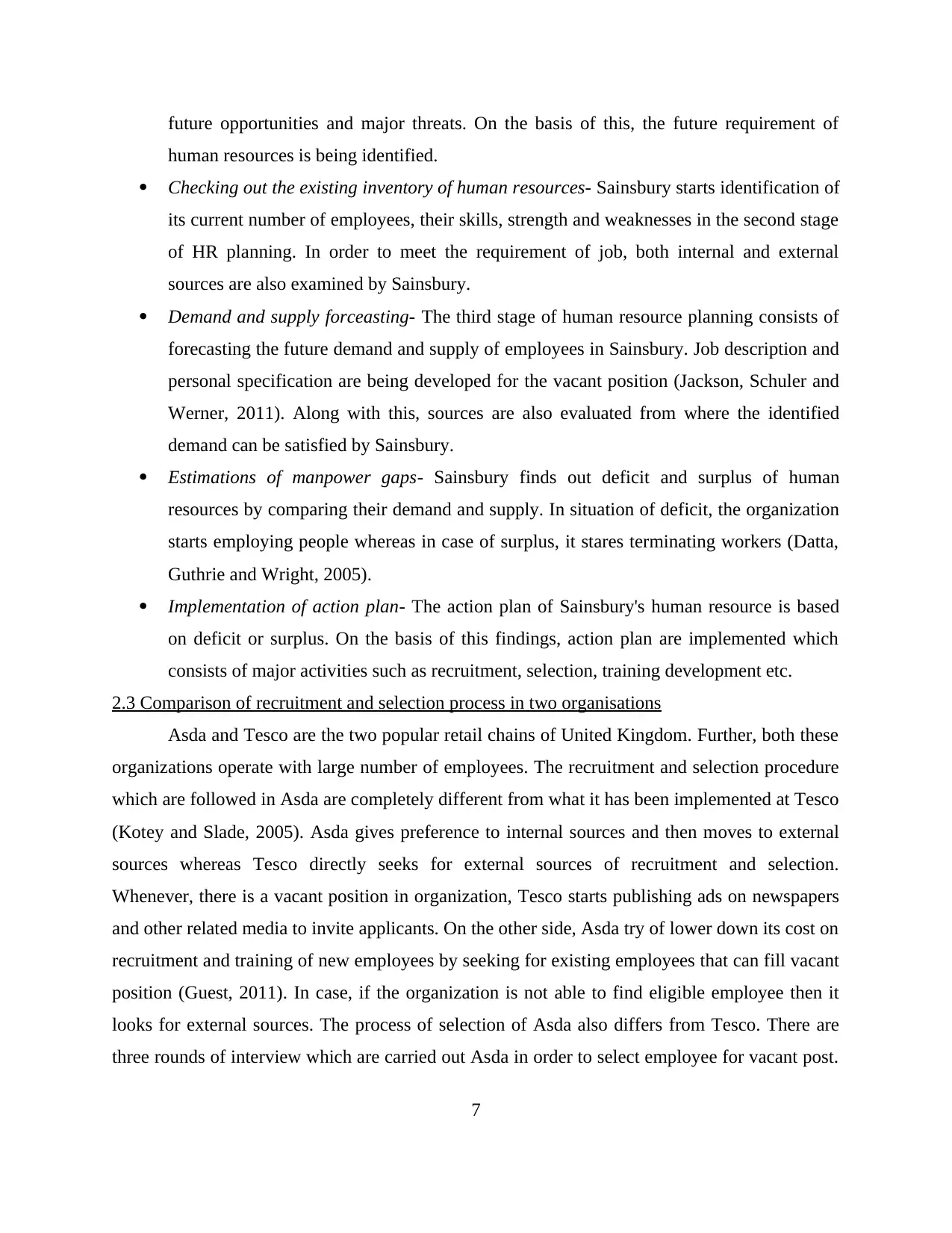
future opportunities and major threats. On the basis of this, the future requirement of
human resources is being identified.
Checking out the existing inventory of human resources- Sainsbury starts identification of
its current number of employees, their skills, strength and weaknesses in the second stage
of HR planning. In order to meet the requirement of job, both internal and external
sources are also examined by Sainsbury.
Demand and supply forceasting- The third stage of human resource planning consists of
forecasting the future demand and supply of employees in Sainsbury. Job description and
personal specification are being developed for the vacant position (Jackson, Schuler and
Werner, 2011). Along with this, sources are also evaluated from where the identified
demand can be satisfied by Sainsbury.
Estimations of manpower gaps- Sainsbury finds out deficit and surplus of human
resources by comparing their demand and supply. In situation of deficit, the organization
starts employing people whereas in case of surplus, it stares terminating workers (Datta,
Guthrie and Wright, 2005).
Implementation of action plan- The action plan of Sainsbury's human resource is based
on deficit or surplus. On the basis of this findings, action plan are implemented which
consists of major activities such as recruitment, selection, training development etc.
2.3 Comparison of recruitment and selection process in two organisations
Asda and Tesco are the two popular retail chains of United Kingdom. Further, both these
organizations operate with large number of employees. The recruitment and selection procedure
which are followed in Asda are completely different from what it has been implemented at Tesco
(Kotey and Slade, 2005). Asda gives preference to internal sources and then moves to external
sources whereas Tesco directly seeks for external sources of recruitment and selection.
Whenever, there is a vacant position in organization, Tesco starts publishing ads on newspapers
and other related media to invite applicants. On the other side, Asda try of lower down its cost on
recruitment and training of new employees by seeking for existing employees that can fill vacant
position (Guest, 2011). In case, if the organization is not able to find eligible employee then it
looks for external sources. The process of selection of Asda also differs from Tesco. There are
three rounds of interview which are carried out Asda in order to select employee for vacant post.
7
human resources is being identified.
Checking out the existing inventory of human resources- Sainsbury starts identification of
its current number of employees, their skills, strength and weaknesses in the second stage
of HR planning. In order to meet the requirement of job, both internal and external
sources are also examined by Sainsbury.
Demand and supply forceasting- The third stage of human resource planning consists of
forecasting the future demand and supply of employees in Sainsbury. Job description and
personal specification are being developed for the vacant position (Jackson, Schuler and
Werner, 2011). Along with this, sources are also evaluated from where the identified
demand can be satisfied by Sainsbury.
Estimations of manpower gaps- Sainsbury finds out deficit and surplus of human
resources by comparing their demand and supply. In situation of deficit, the organization
starts employing people whereas in case of surplus, it stares terminating workers (Datta,
Guthrie and Wright, 2005).
Implementation of action plan- The action plan of Sainsbury's human resource is based
on deficit or surplus. On the basis of this findings, action plan are implemented which
consists of major activities such as recruitment, selection, training development etc.
2.3 Comparison of recruitment and selection process in two organisations
Asda and Tesco are the two popular retail chains of United Kingdom. Further, both these
organizations operate with large number of employees. The recruitment and selection procedure
which are followed in Asda are completely different from what it has been implemented at Tesco
(Kotey and Slade, 2005). Asda gives preference to internal sources and then moves to external
sources whereas Tesco directly seeks for external sources of recruitment and selection.
Whenever, there is a vacant position in organization, Tesco starts publishing ads on newspapers
and other related media to invite applicants. On the other side, Asda try of lower down its cost on
recruitment and training of new employees by seeking for existing employees that can fill vacant
position (Guest, 2011). In case, if the organization is not able to find eligible employee then it
looks for external sources. The process of selection of Asda also differs from Tesco. There are
three rounds of interview which are carried out Asda in order to select employee for vacant post.
7
Paraphrase This Document
Need a fresh take? Get an instant paraphrase of this document with our AI Paraphraser
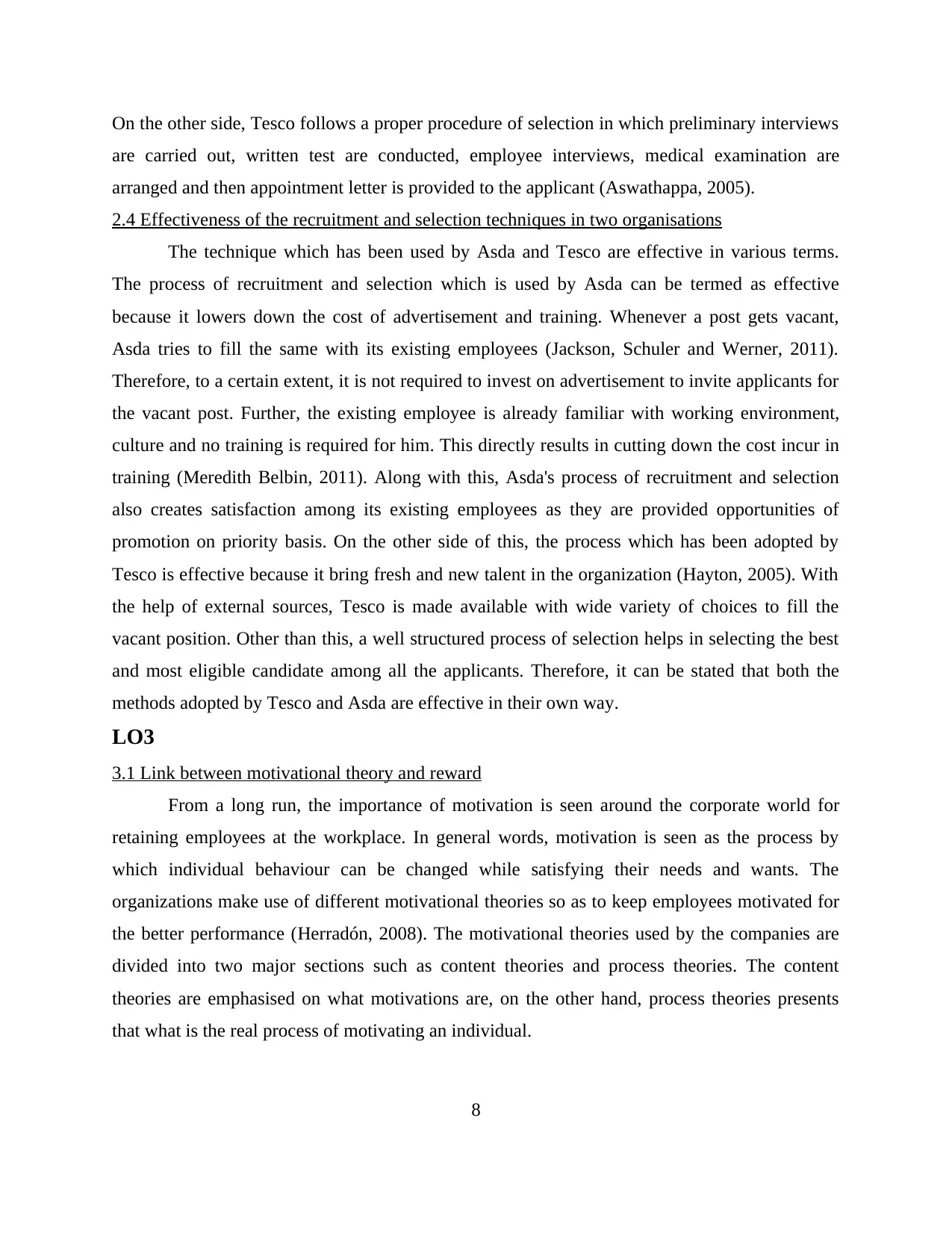
On the other side, Tesco follows a proper procedure of selection in which preliminary interviews
are carried out, written test are conducted, employee interviews, medical examination are
arranged and then appointment letter is provided to the applicant (Aswathappa, 2005).
2.4 Effectiveness of the recruitment and selection techniques in two organisations
The technique which has been used by Asda and Tesco are effective in various terms.
The process of recruitment and selection which is used by Asda can be termed as effective
because it lowers down the cost of advertisement and training. Whenever a post gets vacant,
Asda tries to fill the same with its existing employees (Jackson, Schuler and Werner, 2011).
Therefore, to a certain extent, it is not required to invest on advertisement to invite applicants for
the vacant post. Further, the existing employee is already familiar with working environment,
culture and no training is required for him. This directly results in cutting down the cost incur in
training (Meredith Belbin, 2011). Along with this, Asda's process of recruitment and selection
also creates satisfaction among its existing employees as they are provided opportunities of
promotion on priority basis. On the other side of this, the process which has been adopted by
Tesco is effective because it bring fresh and new talent in the organization (Hayton, 2005). With
the help of external sources, Tesco is made available with wide variety of choices to fill the
vacant position. Other than this, a well structured process of selection helps in selecting the best
and most eligible candidate among all the applicants. Therefore, it can be stated that both the
methods adopted by Tesco and Asda are effective in their own way.
LO3
3.1 Link between motivational theory and reward
From a long run, the importance of motivation is seen around the corporate world for
retaining employees at the workplace. In general words, motivation is seen as the process by
which individual behaviour can be changed while satisfying their needs and wants. The
organizations make use of different motivational theories so as to keep employees motivated for
the better performance (Herradón, 2008). The motivational theories used by the companies are
divided into two major sections such as content theories and process theories. The content
theories are emphasised on what motivations are, on the other hand, process theories presents
that what is the real process of motivating an individual.
8
are carried out, written test are conducted, employee interviews, medical examination are
arranged and then appointment letter is provided to the applicant (Aswathappa, 2005).
2.4 Effectiveness of the recruitment and selection techniques in two organisations
The technique which has been used by Asda and Tesco are effective in various terms.
The process of recruitment and selection which is used by Asda can be termed as effective
because it lowers down the cost of advertisement and training. Whenever a post gets vacant,
Asda tries to fill the same with its existing employees (Jackson, Schuler and Werner, 2011).
Therefore, to a certain extent, it is not required to invest on advertisement to invite applicants for
the vacant post. Further, the existing employee is already familiar with working environment,
culture and no training is required for him. This directly results in cutting down the cost incur in
training (Meredith Belbin, 2011). Along with this, Asda's process of recruitment and selection
also creates satisfaction among its existing employees as they are provided opportunities of
promotion on priority basis. On the other side of this, the process which has been adopted by
Tesco is effective because it bring fresh and new talent in the organization (Hayton, 2005). With
the help of external sources, Tesco is made available with wide variety of choices to fill the
vacant position. Other than this, a well structured process of selection helps in selecting the best
and most eligible candidate among all the applicants. Therefore, it can be stated that both the
methods adopted by Tesco and Asda are effective in their own way.
LO3
3.1 Link between motivational theory and reward
From a long run, the importance of motivation is seen around the corporate world for
retaining employees at the workplace. In general words, motivation is seen as the process by
which individual behaviour can be changed while satisfying their needs and wants. The
organizations make use of different motivational theories so as to keep employees motivated for
the better performance (Herradón, 2008). The motivational theories used by the companies are
divided into two major sections such as content theories and process theories. The content
theories are emphasised on what motivations are, on the other hand, process theories presents
that what is the real process of motivating an individual.
8
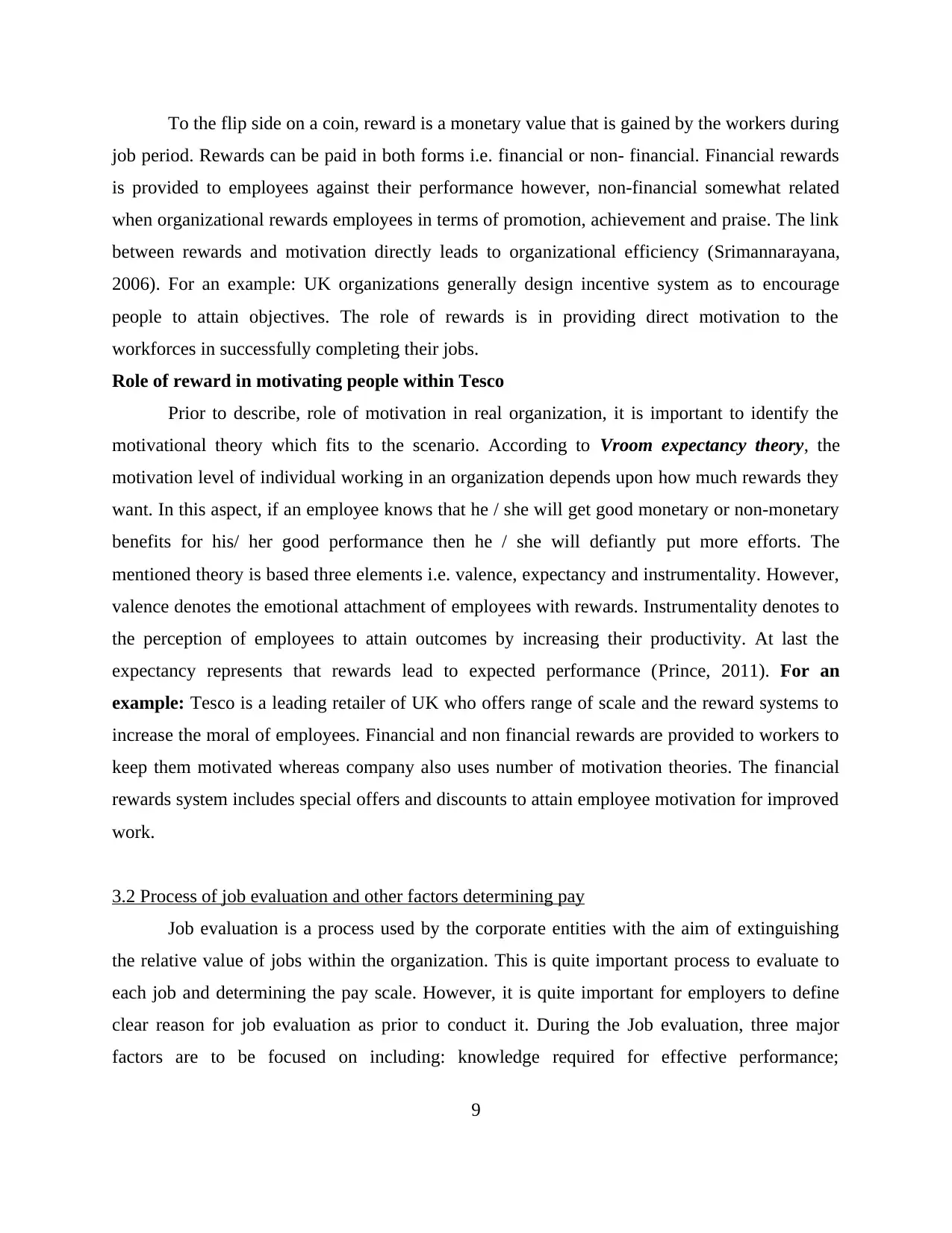
To the flip side on a coin, reward is a monetary value that is gained by the workers during
job period. Rewards can be paid in both forms i.e. financial or non- financial. Financial rewards
is provided to employees against their performance however, non-financial somewhat related
when organizational rewards employees in terms of promotion, achievement and praise. The link
between rewards and motivation directly leads to organizational efficiency (Srimannarayana,
2006). For an example: UK organizations generally design incentive system as to encourage
people to attain objectives. The role of rewards is in providing direct motivation to the
workforces in successfully completing their jobs.
Role of reward in motivating people within Tesco
Prior to describe, role of motivation in real organization, it is important to identify the
motivational theory which fits to the scenario. According to Vroom expectancy theory, the
motivation level of individual working in an organization depends upon how much rewards they
want. In this aspect, if an employee knows that he / she will get good monetary or non-monetary
benefits for his/ her good performance then he / she will defiantly put more efforts. The
mentioned theory is based three elements i.e. valence, expectancy and instrumentality. However,
valence denotes the emotional attachment of employees with rewards. Instrumentality denotes to
the perception of employees to attain outcomes by increasing their productivity. At last the
expectancy represents that rewards lead to expected performance (Prince, 2011). For an
example: Tesco is a leading retailer of UK who offers range of scale and the reward systems to
increase the moral of employees. Financial and non financial rewards are provided to workers to
keep them motivated whereas company also uses number of motivation theories. The financial
rewards system includes special offers and discounts to attain employee motivation for improved
work.
3.2 Process of job evaluation and other factors determining pay
Job evaluation is a process used by the corporate entities with the aim of extinguishing
the relative value of jobs within the organization. This is quite important process to evaluate to
each job and determining the pay scale. However, it is quite important for employers to define
clear reason for job evaluation as prior to conduct it. During the Job evaluation, three major
factors are to be focused on including: knowledge required for effective performance;
9
job period. Rewards can be paid in both forms i.e. financial or non- financial. Financial rewards
is provided to employees against their performance however, non-financial somewhat related
when organizational rewards employees in terms of promotion, achievement and praise. The link
between rewards and motivation directly leads to organizational efficiency (Srimannarayana,
2006). For an example: UK organizations generally design incentive system as to encourage
people to attain objectives. The role of rewards is in providing direct motivation to the
workforces in successfully completing their jobs.
Role of reward in motivating people within Tesco
Prior to describe, role of motivation in real organization, it is important to identify the
motivational theory which fits to the scenario. According to Vroom expectancy theory, the
motivation level of individual working in an organization depends upon how much rewards they
want. In this aspect, if an employee knows that he / she will get good monetary or non-monetary
benefits for his/ her good performance then he / she will defiantly put more efforts. The
mentioned theory is based three elements i.e. valence, expectancy and instrumentality. However,
valence denotes the emotional attachment of employees with rewards. Instrumentality denotes to
the perception of employees to attain outcomes by increasing their productivity. At last the
expectancy represents that rewards lead to expected performance (Prince, 2011). For an
example: Tesco is a leading retailer of UK who offers range of scale and the reward systems to
increase the moral of employees. Financial and non financial rewards are provided to workers to
keep them motivated whereas company also uses number of motivation theories. The financial
rewards system includes special offers and discounts to attain employee motivation for improved
work.
3.2 Process of job evaluation and other factors determining pay
Job evaluation is a process used by the corporate entities with the aim of extinguishing
the relative value of jobs within the organization. This is quite important process to evaluate to
each job and determining the pay scale. However, it is quite important for employers to define
clear reason for job evaluation as prior to conduct it. During the Job evaluation, three major
factors are to be focused on including: knowledge required for effective performance;
9
⊘ This is a preview!⊘
Do you want full access?
Subscribe today to unlock all pages.

Trusted by 1+ million students worldwide
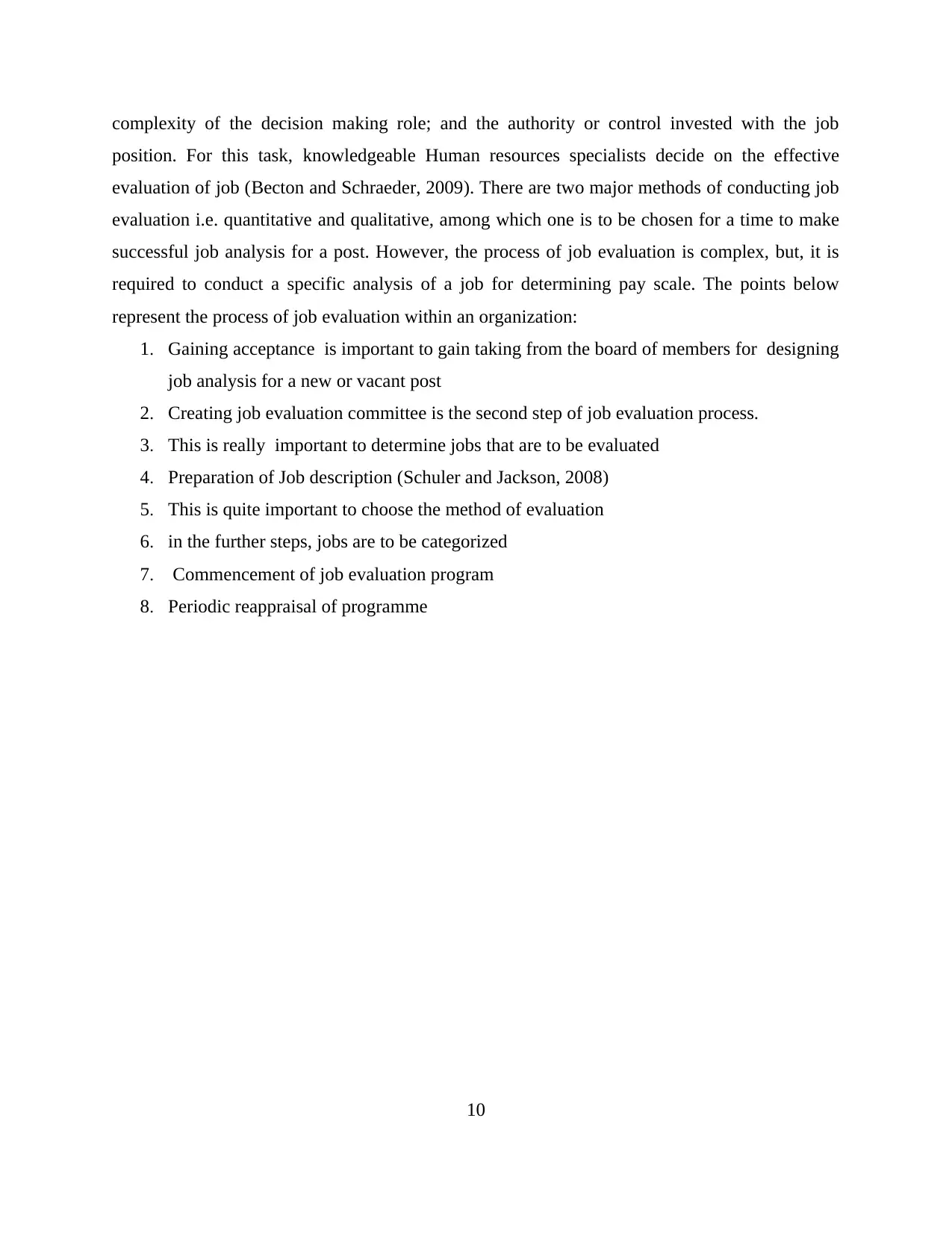
complexity of the decision making role; and the authority or control invested with the job
position. For this task, knowledgeable Human resources specialists decide on the effective
evaluation of job (Becton and Schraeder, 2009). There are two major methods of conducting job
evaluation i.e. quantitative and qualitative, among which one is to be chosen for a time to make
successful job analysis for a post. However, the process of job evaluation is complex, but, it is
required to conduct a specific analysis of a job for determining pay scale. The points below
represent the process of job evaluation within an organization:
1. Gaining acceptance is important to gain taking from the board of members for designing
job analysis for a new or vacant post
2. Creating job evaluation committee is the second step of job evaluation process.
3. This is really important to determine jobs that are to be evaluated
4. Preparation of Job description (Schuler and Jackson, 2008)
5. This is quite important to choose the method of evaluation
6. in the further steps, jobs are to be categorized
7. Commencement of job evaluation program
8. Periodic reappraisal of programme
10
position. For this task, knowledgeable Human resources specialists decide on the effective
evaluation of job (Becton and Schraeder, 2009). There are two major methods of conducting job
evaluation i.e. quantitative and qualitative, among which one is to be chosen for a time to make
successful job analysis for a post. However, the process of job evaluation is complex, but, it is
required to conduct a specific analysis of a job for determining pay scale. The points below
represent the process of job evaluation within an organization:
1. Gaining acceptance is important to gain taking from the board of members for designing
job analysis for a new or vacant post
2. Creating job evaluation committee is the second step of job evaluation process.
3. This is really important to determine jobs that are to be evaluated
4. Preparation of Job description (Schuler and Jackson, 2008)
5. This is quite important to choose the method of evaluation
6. in the further steps, jobs are to be categorized
7. Commencement of job evaluation program
8. Periodic reappraisal of programme
10
Paraphrase This Document
Need a fresh take? Get an instant paraphrase of this document with our AI Paraphraser
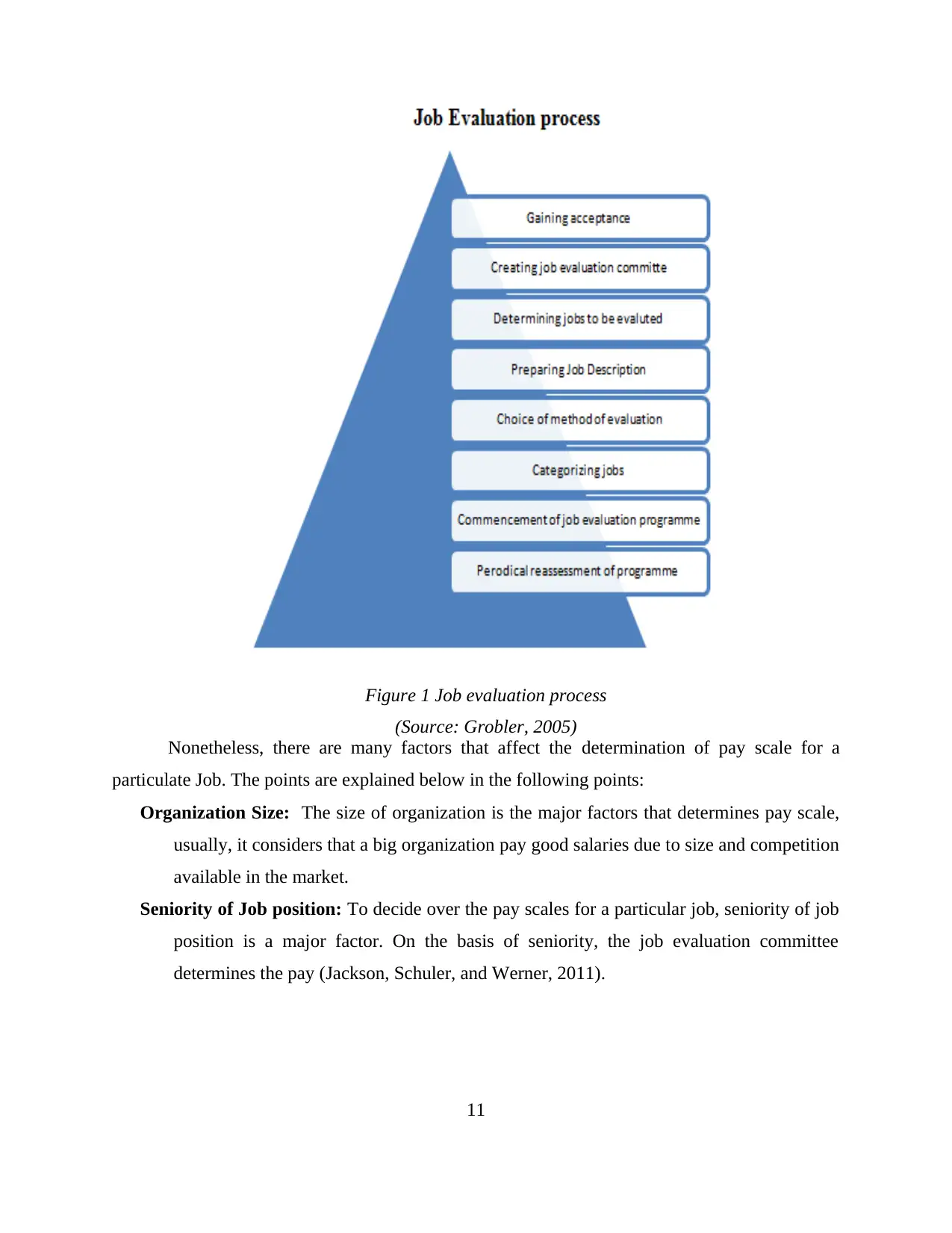
Nonetheless, there are many factors that affect the determination of pay scale for a
particulate Job. The points are explained below in the following points:
Organization Size: The size of organization is the major factors that determines pay scale,
usually, it considers that a big organization pay good salaries due to size and competition
available in the market.
Seniority of Job position: To decide over the pay scales for a particular job, seniority of job
position is a major factor. On the basis of seniority, the job evaluation committee
determines the pay (Jackson, Schuler, and Werner, 2011).
11
Figure 1 Job evaluation process
(Source: Grobler, 2005)
particulate Job. The points are explained below in the following points:
Organization Size: The size of organization is the major factors that determines pay scale,
usually, it considers that a big organization pay good salaries due to size and competition
available in the market.
Seniority of Job position: To decide over the pay scales for a particular job, seniority of job
position is a major factor. On the basis of seniority, the job evaluation committee
determines the pay (Jackson, Schuler, and Werner, 2011).
11
Figure 1 Job evaluation process
(Source: Grobler, 2005)
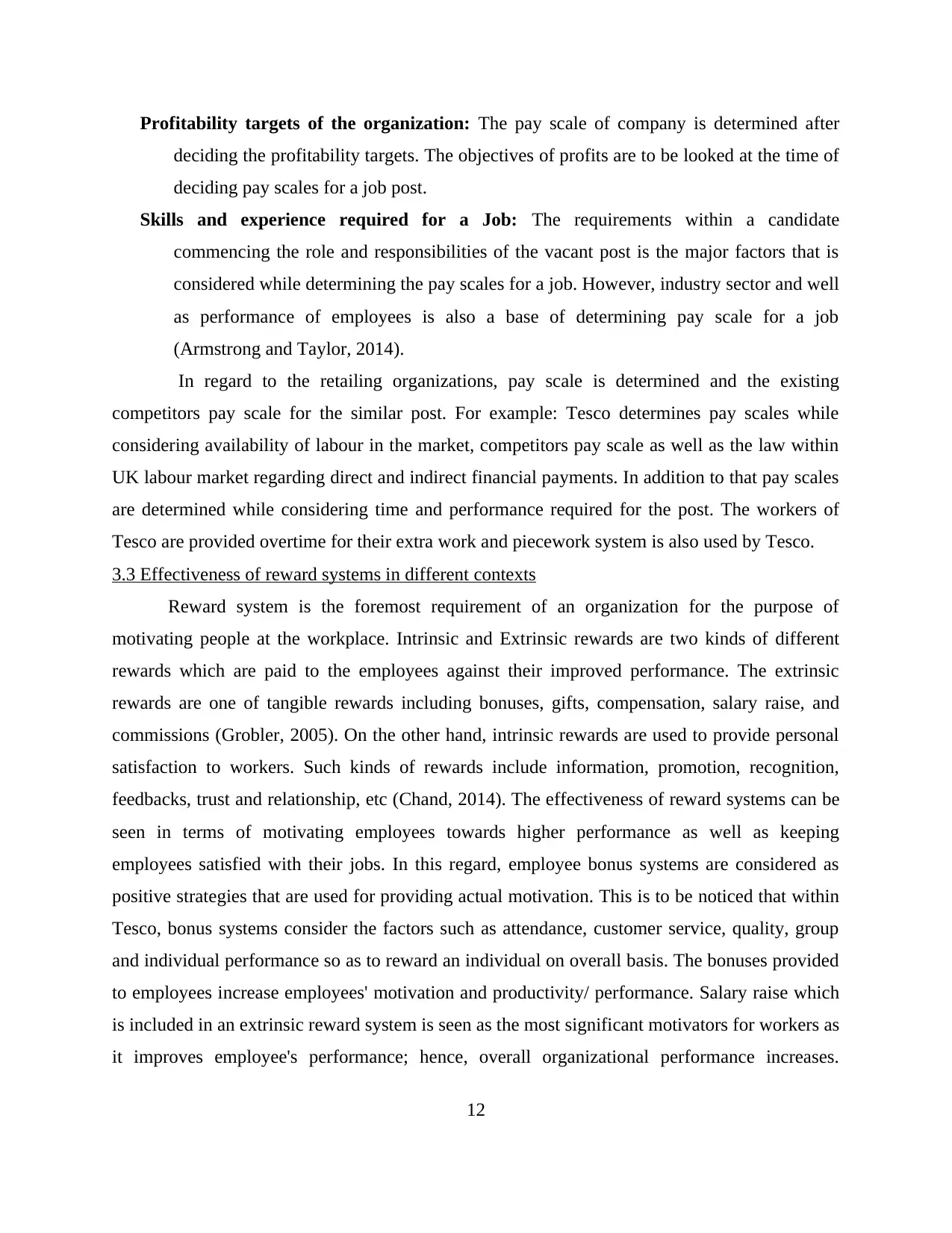
Profitability targets of the organization: The pay scale of company is determined after
deciding the profitability targets. The objectives of profits are to be looked at the time of
deciding pay scales for a job post.
Skills and experience required for a Job: The requirements within a candidate
commencing the role and responsibilities of the vacant post is the major factors that is
considered while determining the pay scales for a job. However, industry sector and well
as performance of employees is also a base of determining pay scale for a job
(Armstrong and Taylor, 2014).
In regard to the retailing organizations, pay scale is determined and the existing
competitors pay scale for the similar post. For example: Tesco determines pay scales while
considering availability of labour in the market, competitors pay scale as well as the law within
UK labour market regarding direct and indirect financial payments. In addition to that pay scales
are determined while considering time and performance required for the post. The workers of
Tesco are provided overtime for their extra work and piecework system is also used by Tesco.
3.3 Effectiveness of reward systems in different contexts
Reward system is the foremost requirement of an organization for the purpose of
motivating people at the workplace. Intrinsic and Extrinsic rewards are two kinds of different
rewards which are paid to the employees against their improved performance. The extrinsic
rewards are one of tangible rewards including bonuses, gifts, compensation, salary raise, and
commissions (Grobler, 2005). On the other hand, intrinsic rewards are used to provide personal
satisfaction to workers. Such kinds of rewards include information, promotion, recognition,
feedbacks, trust and relationship, etc (Chand, 2014). The effectiveness of reward systems can be
seen in terms of motivating employees towards higher performance as well as keeping
employees satisfied with their jobs. In this regard, employee bonus systems are considered as
positive strategies that are used for providing actual motivation. This is to be noticed that within
Tesco, bonus systems consider the factors such as attendance, customer service, quality, group
and individual performance so as to reward an individual on overall basis. The bonuses provided
to employees increase employees' motivation and productivity/ performance. Salary raise which
is included in an extrinsic reward system is seen as the most significant motivators for workers as
it improves employee's performance; hence, overall organizational performance increases.
12
deciding the profitability targets. The objectives of profits are to be looked at the time of
deciding pay scales for a job post.
Skills and experience required for a Job: The requirements within a candidate
commencing the role and responsibilities of the vacant post is the major factors that is
considered while determining the pay scales for a job. However, industry sector and well
as performance of employees is also a base of determining pay scale for a job
(Armstrong and Taylor, 2014).
In regard to the retailing organizations, pay scale is determined and the existing
competitors pay scale for the similar post. For example: Tesco determines pay scales while
considering availability of labour in the market, competitors pay scale as well as the law within
UK labour market regarding direct and indirect financial payments. In addition to that pay scales
are determined while considering time and performance required for the post. The workers of
Tesco are provided overtime for their extra work and piecework system is also used by Tesco.
3.3 Effectiveness of reward systems in different contexts
Reward system is the foremost requirement of an organization for the purpose of
motivating people at the workplace. Intrinsic and Extrinsic rewards are two kinds of different
rewards which are paid to the employees against their improved performance. The extrinsic
rewards are one of tangible rewards including bonuses, gifts, compensation, salary raise, and
commissions (Grobler, 2005). On the other hand, intrinsic rewards are used to provide personal
satisfaction to workers. Such kinds of rewards include information, promotion, recognition,
feedbacks, trust and relationship, etc (Chand, 2014). The effectiveness of reward systems can be
seen in terms of motivating employees towards higher performance as well as keeping
employees satisfied with their jobs. In this regard, employee bonus systems are considered as
positive strategies that are used for providing actual motivation. This is to be noticed that within
Tesco, bonus systems consider the factors such as attendance, customer service, quality, group
and individual performance so as to reward an individual on overall basis. The bonuses provided
to employees increase employees' motivation and productivity/ performance. Salary raise which
is included in an extrinsic reward system is seen as the most significant motivators for workers as
it improves employee's performance; hence, overall organizational performance increases.
12
⊘ This is a preview!⊘
Do you want full access?
Subscribe today to unlock all pages.

Trusted by 1+ million students worldwide
1 out of 18
Related Documents
Your All-in-One AI-Powered Toolkit for Academic Success.
+13062052269
info@desklib.com
Available 24*7 on WhatsApp / Email
![[object Object]](/_next/static/media/star-bottom.7253800d.svg)
Unlock your academic potential
Copyright © 2020–2025 A2Z Services. All Rights Reserved. Developed and managed by ZUCOL.





